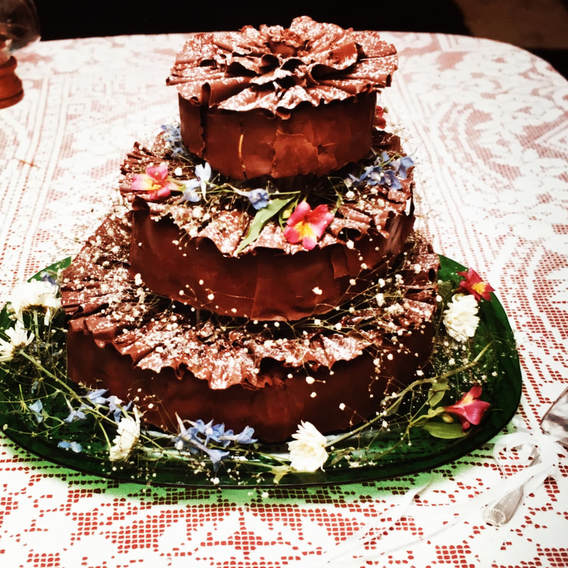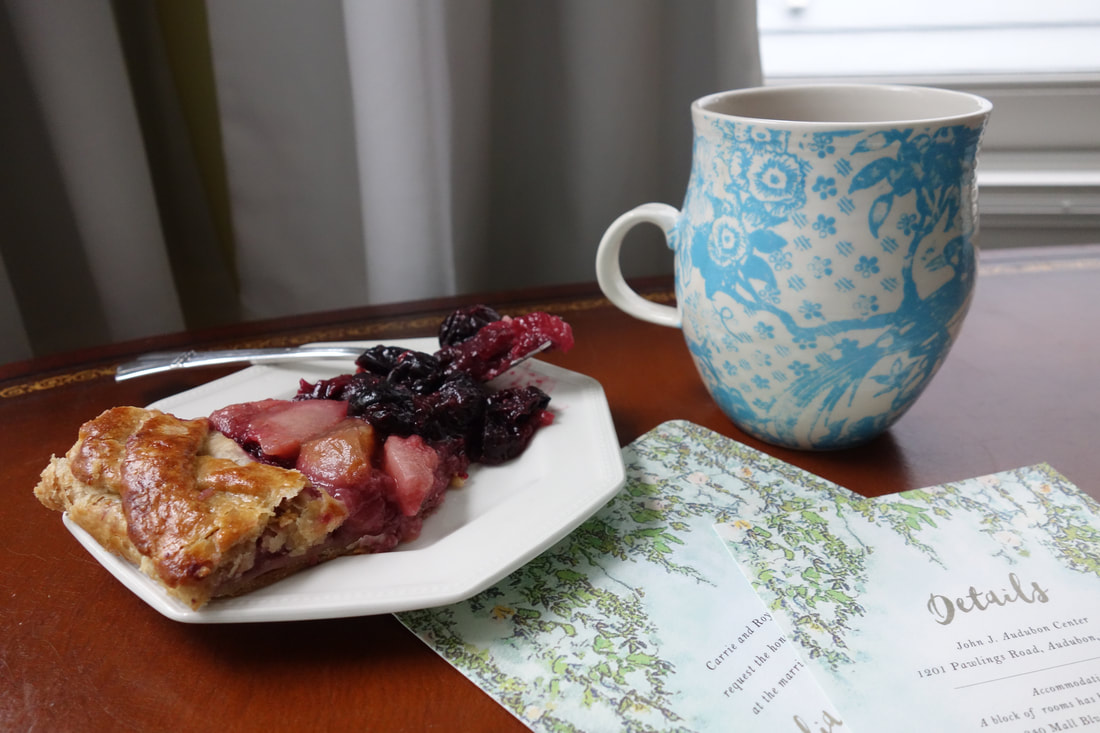|
My wedding cake was baked by my college roommate, Betsy. It was the most glorious combination of vanilla genoise cradling dark chocolate mousse. Instead of buttercream, each tier was wrapped in a wide ribbon of chocolate, the top covered in chocolate ruffles. Betsy and our friend, Pamela, packed each tier in individual white bakery boxes and drove the cake from Connecticut to New Jersey. They assembled the cake when they arrived, tucking sprays of baby’s breath and autumn flowers between the tiers. In today’s vernacular, you would say the cake was assembled “on site.” I didn’t think of it as a “site”- I thought of it as my parent’s dining room table.
I still dream about that cake, remembering how we packed up the top tier in a makeshift box, squeezing it into our cramped freezer on East 97th Street. More vividly, I recall repeatedly opening the door to the freezer, slicing off slivers of chocolate ruffle cake until it was gone. First Anniversary cake never had a chance. In the 1980s, I baked a wedding cake for my college friends, Mary and Jim. The cake was rich with sour cream and studded with miniature chocolate chips. The bottom tier measured 14” in diameter, requiring me to constantly adjust the oven temperature downwards so the center of the cake would bake evenly and the edges wouldn’t over bake. The size of the middle tier escapes me, but the top tier was the requisite 6” because I knew Mary and Jim would freeze the top tier to eat on their anniversary. I do remember making several batches of Italian meringue buttercream, waiting impatiently for the sugar syrup to reach 238 degrees on a candy thermometer. My wrist wobbled under the weight of the heavy-bottomed saucepan as I tried to avoid splashing sugar syrup on the mixer’s whisk attachment. The softly beaten egg whites combined with cubes of cool, not cold, butter morphed into velvety buttercream, fragrant with vanilla. Lavishly yet imperfectly iced, I placed fresh flowers hither and thither amongst the tiers, aiming for a look both casual yet elegant. The buttercream alone warranted a cardiac care team standing by. This was long before Etsy and Craftsy, Jet Fete and the Knot. The term ‘destination wedding’ had yet to be part of the vernacular and wedding invitations arrived by snail mail. Miraculously, without benefit of Google maps guests found their way. I attended a handful of weddings as a guest, dozens as a wedding cake ‘vendor.’ Wedding cakes were tiered, iced in buttercream, more often than not piped in basketweave, and festooned with botannicals. A decade later, fresh flowers began to make way for flowers grown on small farms, painstakingly painted with organic egg whites and dipped in sugar. It was also the beginning of the end of buttercream. I hung up my piping bag with the basketweave tip and learned how to roll fondant. The 1990s also ushered in a quiet movement with the farm to table folks; pie was beginning to make its entrance at wedding receptions. The antithesis to the formal wedding, casual weddings were on the rise. Receptions were celebrated lakeside and oceanside, in barns, open fields, and vineyards. Pie was far less stuffy than wedding cake and from my vantage point, so much easier to deliver. My very first encounter with a Pie Bride was in the mid 1990s. The bride ordered one dozen pies in various flavors to be delivered to a barn somewhere in New Hope, Pa. Missing was the requisite skirted cake table decorated with generic florist greens. Instead, a picnic table draped in red and white gingham held bell jars filled with sunflowers. I set the pies on pedestal cake platters of various heights and looked around; nothing matched and it was perfect. To be fair, pies and weddings go as far back as four-and-twenty-blackbirds-baked- in-a-pie, pie. In the 16th century, ‘Surprise Pyes’ and 'Bride Pie' were a common hybrid of dessert and entertainment. Large pastry shells, depressingly dubbed coffins, were baked with a large cavity, capable of holding small live birds. When the lid of the pastry was removed, the birds flew out, to the surprise (or horror) of the guests. Bride Pie is mentioned in Robert May’s, The Accomplish’t Cook. Written in 1660, Bride Pie was an assemblage of several pies, boasting assorted fillings. Mr. May suggests “oysters, prawns, cockles, and artichocks.” He also proposes (in olde English vernacular) the use of “live birds, or a snake, which will seem strange to the beholder, which cut up the Pie at the table. This is onely for a Wedding to pass away time.” Clearly it was years before Mr. May and his guests would pass away the time dancing to YMCA and the Macarena. It is no surprise to learn a common ingredient found in each of Mr. May’s recipes is butter; the only ingredient I am willing to borrow from his compendium. This weekend will find me surrounded by my favorite people, celebrating the marriage of Julia and Blake. We will be enjoying slices of wedding pie and local ice cream in our old stomping grounds of Philadelphia. I hope I don't find a surprise in the pies.
0 Comments
Leave a Reply. |
Archives
July 2024
Ellen GrayProfessional Pie-isms & Seasonal Sarcasm Categories |


 RSS Feed
RSS Feed